By Abbey Smith

Getting into the water is a great way for amputees to be active, get exercise, and have a great time. For many amputees, it’s also a wonderful part of life they don’t want to give up—and shouldn’t have to.
“There are so many benefits of exercising in water,” explains Carol Sames, PhD, an associate professor in the College of Health Professionals at the State University of New York (SUNY) Upstate Medical University, Syracuse. “Water provides a supportive, buoyant environment, which can be ideal for many amputees who find traditional exercise or other weight bearing activities difficult, or for those who have chronic pain or limited range of motion.”
People can move in water in ways they can’t move on land, which makes water an empowering place for many amputees whose mobility may be limited elsewhere. According to Sames, who also serves as the director of SUNY’s Vitality Fitness Program, water provides a different tactile function that alters the central and peripheral nervous systems and reduces pain perception. This may be especially helpful for amputees who experience residual or phantom limb pain as a result of their amputations.
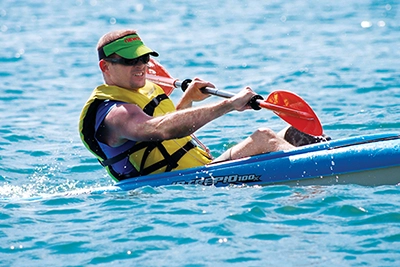
Water-based exercise offers a multitude of other health benefits as well. The Aquatic Exercise Association estimates that people burn about 400 to 500 calories per hour when exercising in water. The Centers for Disease Control and Prevention reports that water-based exercise can help decrease the risk of developing chronic illnesses, such as diabetes and heart disease, and alleviate symptoms of arthritis and rheumatoid arthritis. Furthermore, water offers 12 times more resistance than air, making it a great place for stretching, building and maintaining muscle strength, and improving overall flexibility.
“In water, we talk about center of buoyancy rather than center of gravity,” Sames says. “Your center of buoyancy is higher than your center of gravity due to the air in your lungs. When you’re chest-deep in water, you can weigh as much as 80 percent less than when you’re on land. This also means there’s less impact and pressure on your joints compared to land-based exercise.”
Making a Splash
When people ask Christina Lang if it’s hard swimming with only one leg, she says she’s never sure how to answer the question because she hasn’t ever swum with two legs.
“People are usually surprised when I tell them I can’t swim with my prosthetic leg,” says Lang, who lost her left leg below the knee due to a blood infection from the chicken pox virus when she was 2 years old. “They also want to know if I can use both legs when I swim, and I tell them yes, because my thigh muscles allow me to kick.”
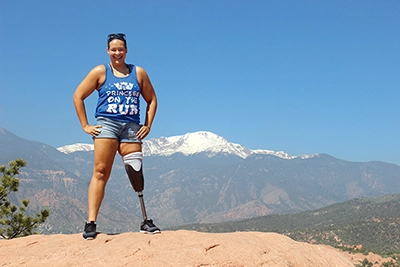
Image courtesy of Christina Lang.
Lang, who started swimming for fun when she was 13, is now a high school senior and trains several hours a day, six days a week with a goal of competing in the 2020 Summer Paralympic Games in Tokyo. Although she’s earned numerous awards for her feats—including setting national records in swimming at the National Junior Disability Championships last July and making the 2015 U.S. Paralympics Track and Field High School All-Americans Team for discus—she’s no stranger to people questioning her abilities. She’s found, however, that the best way to change these perceptions is to show people she can not only keep up with able-bodied swimmers but can often outperform them.
“I’m used to getting shocked looks when I swim against able-bodied athletes,” she says. “Some swimmers have given me a hard time because I’m on their team, and I’ve had coaches who wouldn’t train me the same way as able-bodied swimmers because they thought I couldn’t do it. Sometimes I may need to learn a different way to master a particular skill, but I never use my amputation as an excuse not to train hard or do my best.”
She says swimming continues to show her that she can do anything she puts her mind to doing.
“I love swimming because it’s a mental and physical sport that pushes me and helps me realize how strong I can be,” she says. “It’s also taught me to accept defeat, to work harder to win, and not to judge a person’s ability based on appearances.”
One Wave at a Time
A native of Southern France, Eric Dargent has spent most of his life waterside. He began surfing at age 9 and instantly fell in love with the feeling of gliding across the water. Since then, surfing has become his passion—something he’s built his whole life around.
After losing his left leg above the knee following a shark attack near Réunion Island in 2011, he was told he wouldn’t be able to surf again. Dargent, however, had other plans. He dedicated himself to returning to his surfboard and founded Surfeurs Dargent (which translates to Silver Surfers), an organization that promotes adaptive sports, including the development of affordable prostheses to better enable amputees to participate in athletics.
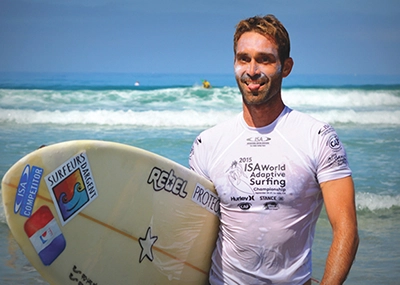
World Adaptive Surfing Championship.
Image courtesy of PROTEOR Handicap Technologie.
“I never gave up because I couldn’t consider a life without surfing,” he says. “This experience has been long, hard, and frustrating, and I wouldn’t have ever succeeded without the support of my family and friends.”
Dargent continues to follow the path to success and isn’t slowing down anytime soon. He took part in the International Surfing Association’s inaugural World Adaptive Surfing Championship last September and won the first adaptive surfing competition during the French Surfing Championship last October. He also enjoys skateboarding, snowboarding, and mountain biking, and recently started playing Basque pelota, which is played by hitting a ball against a wall with a racket.
“To me—above all things—being a part of these competitions, being alive, and enjoying every moment is a real happiness in itself,” says Dargent, who trains between one and two hours every day. “When I’m surfing, I feel like I’m flying. My spirit focuses on everything around me, and I can feel the power of adrenaline in my blood. I forget about my prosthesis and feel the pleasure of being alive!”
He’s quick to point out that regardless of someone’s experience or ability to lie, kneel, or stand on a surfboard, he or she can find pleasure in surfing.
“What I find fantastic is how minds have changed toward disability,” he says. “I dreamt that disability would become a part of surfing history, and now it’s happening. You must always follow your dreams and do your best to make them come true.”
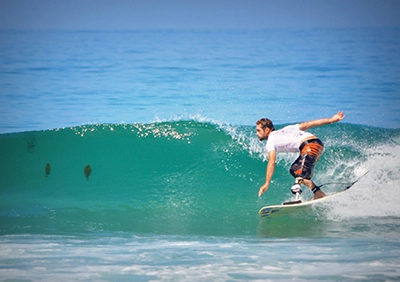
Image courtesy of PROTEOR Handicap Technologie.
Eric Dargent is fitted by BTC Orthopédie.
Falling Isn’t Failing
David Patterson started waterskiing at age 5 and competed on his local swim team throughout childhood, but his love for water sports turned into his passion after getting his first skurfer (now referred to as a wakeboard) in the early 1990s. In fact, this was a turning point for Patterson, who pursued wakeboarding, both as a rider and a coach, at a professional level after he graduated from high school.
“Being in the water tends to put the world into a better perspective,” Patterson says. “The element of water has always helped me tune out stress and tune in to the moment.”
Now, in addition to completing his residency at Hope Orthotics in Spring, Texas, Patterson, MSOP, focuses on helping amputees enjoy water sports through an ongoing adaptive wakesurfing clinic he and his wife created last year.
“We helped at some adaptive skateboarding events in Houston and thought we could do the same thing for wakeboarding and wakesurfing,” Patterson explains. “Our goal is to get more people on the water by creating a model and a few adaptive surfboards that allow us to share this type of program around the country.”
For a typical event, participants bring their own water-adaptive prostheses, and Patterson provides the rest—including an array of surfboards that range in size, style, and construction to meet each participant’s adaptive needs. Events begin with safety instruction followed by a professional wakesurfer teaching participants the basics on land before heading into the water.
One of the group’s regular instructors is five-time world champion wakesurfer Drew Danielo, who is also one of Patterson’s close friends. Together, they’re planning two events in Texas this summer—one at the Texas Ski Ranch in New Braunfels and the other at Hangar 9, a wakeboarding park in Conroe.
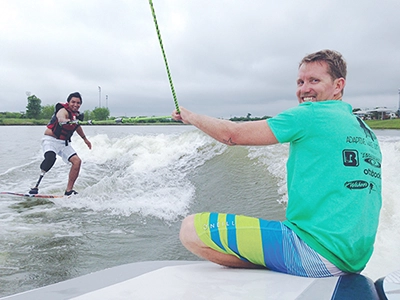
Image by David Patterson.
“During one of our last events, participants ranged in age from 4 to 50 and had various levels of amputations, including a bilateral transfemoral amputee,” Patterson says. “Everyone successfully got up that day. It’s great seeing the excitement and joy on their faces when they finally get up or find the ‘sweet spot’ on the wave.”
Patterson often sees first-time participants doubt their abilities to wakeboard, but he reminds them that it just takes a little time and perseverance.
“Too often, we limit ourselves from our potential,” he says. “We let fear and doubt keep us from doing things we dream of, or we give up after a few attempts. Falling is not failing. You’ve only failed if you give up.”
Taking the Plunge
Amputees of all ages and abilities can take advantage of the benefits water-based sports and activities offer. While swimming may be one of the more common choices, aquatic exercise doesn’t have to be limited to a pool. Adaptive water sports, such as surfing and wakeboarding, can provide exciting new opportunities for many amputees—especially as prosthetic technology continues to improve and become more widely available.
“The body was meant to move, and being an amputee isn’t a barrier to being active,” Sames explains. “Just use some creativity and remember that you can do it.”
AMPUTEES AND WATER CAN MIX
Tips for Participating in Water Activities
It’s not uncommon for amputees to assume that, due to their amputations or prosthetic devices, they’re unable to participate in their favorite water activities. Thanks to evolving technology and the availability of adaptive devices, however, amputees have access to a variety of options for enjoying aquatic activities without damaging their prosthetic limbs.
Before You Dive In
Before starting a water activity, search online and speak with other amputees to learn more about recommended adaptive products and methods. You can also reach out to organizations such as the Challenged Athletes Foundation (www.challengedathletes.org) and the PLAY Foundation (www.playfoundation.net), which are dedicated to helping amputees pursue interests and activities by providing grants, training, and equipment.
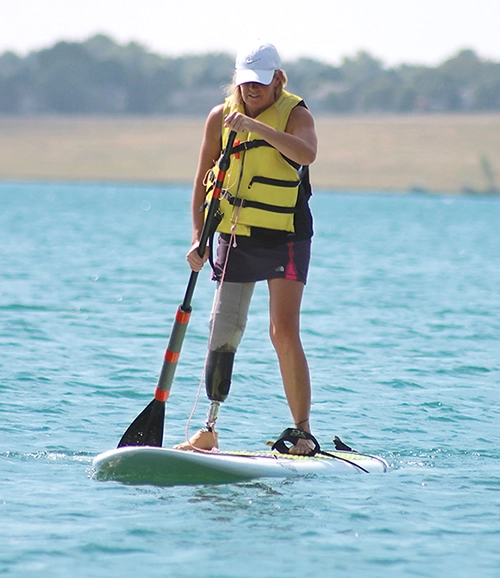
Also talk to your prosthetist about your plans to ensure that you have exactly what you need to have a great time safely. If your prosthesis isn’t designed to be in or near water, for example, your prosthetist can recommend a protective cover or a specialty prosthesis or device that’s suitable for using in the water. This is critical, as moisture can damage many prosthetic limbs and their components.
If you decide to use a secondary or backup prosthesis, it’s important to place your main prosthesis in a safe place while you’re not using it. For instance, if you’re on vacation, consider leaving your prosthesis with someone you know or locking it in your hotel room rather than leaving it lying near the water or in your car. This is especially important when you’re headed to the beach or another warm locale, as high temperatures inside a vehicle can cause serious damage to your prosthesis.
Depending on the type and location of your amputation, you may be able to participate in certain water activities without a prosthesis. Swimming pools, for example, can provide an ideal environment for leg amputees because water’s buoyant properties help support the body, which may eliminate the need to use a prosthetic leg or device.
Surfing for the Right Gear
Following is more information about various prosthetic covers, prostheses, and devices designed for use in water-based activities.
Prosthetic Covers
If your prosthesis isn’t designed to be near water, there are a wide range of protective waterproof coverings that can be used for daily tasks, such as showering, and aquatic activities. These covers are essential for protecting your prosthesis from costly water damage.
The DRYPro is a prosthesis protector with a watertight vacuum seal that can be used in the shower, bathtub, or swimming pool.
www.drycorp.com
The Aqualeg is a hybrid prosthesis that can be worn for everyday use as well as during outdoor activities, such as swimming, kayaking, canoeing, windsurfing, sailing, and rafting.
www.swim-prosthesis.com
Fabtech Systems Advanced Cover Systems protect prostheses from water, snow, and mud during everyday use and sports activities.
www.fabtechsystems.com
Thompson’s Prosthetic Shower Protector keeps prostheses dry while allowing users to shower with confidence and independence. This product is not for swimming or bathing.
www.showerprotector.com
aquashield is a watertight cover to protect a prosthesis or residual limb and can be worn for showering, bathing, and even swimming.
www.aquashieldusa.com
Waterproof Prostheses and Specialized Devices
Aqualine is a line of waterproof prosthetic components for those with below- or above-knee amputations that can be used in the shower or during water activities.
www.ottobockus.com
The X3 is a waterproof microprocessor-controlled prosthetic leg that can be submerged in water.
www.ottobockus.com
Aulie Prosthetic Devices manufactures nylon prosthetic knees that can be used in the pool, beach, or garden.
www.auliedevices.com
Standard Cyborg manufactures a waterproof, 3D-printed prosthesis for below-knee amputees. It can be used in the shower, bathtub, or swimming pool and can be worn at the beach or while boating.
www.standardcyborg.com
TRS prosthetics makes several prosthetic devices specifically for swimming and surfing, including a freestyle swimming device and a swim fin kit.
www.trsprosthetics.com
The Swimankle and Activankle are prosthetic ankle joints for swimming, snorkeling, snow skiing, jet skiing, snowmobiling, and rowing.
www.rampro.net
THE SCUBA leg is for below-knee amputees. It has modes for walking and for swimming, which can be switched back and forth while wearing full SCUBA gear and floating in the ocean.
www.pongratz-engineering.com
The WaterGait WaterLeg is designed for below-knee amputees and can be used while in the shower, bathtub, or pool as well as for water activities such as skiing, parasailing, boating, and fishing.
www.watergait.com



